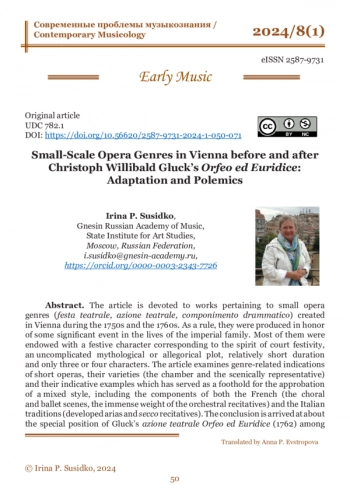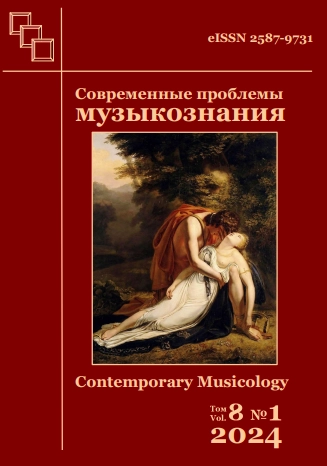Статья посвящена сочинениям малых оперных жанров (festa teatrale, azione teatrale, componimento drammatico), созданным в Вене в 1750–1760-е годы. Как правило, их ставили в честь какого-то значительного события в жизни императорской семьи. Большинство имело праздничный характер, отвечающий духу придворного торжества, несложный мифологический или аллегорический сюжет, небольшую протяженность, всего 3–4-х персонажей. В статье рассмотрены жанровые обозначения малых опер, их разновидности (камерная и сценически-репрезентативная) и показательные образцы, которые послужили плацдармом для апробации смешанного стиля, включающего компоненты как французской (хоровые и балетные сцены, большой вес оркестровых речитативов), так и итальянской традиции (развитые арии, речитативы secco). Сделан вывод об особом положении azione teatrale «Орфей и Эвридика» (1762) К. В. Глюка в ряду аналогичных жанров. Отказ Глюка от монументальной арии обозначил его полемику с поэтикой и оперы seria, и festa teatrale. Несмотря на претворение в «Орфее» значительного количества композиционных приемов festa teatrale, такой отказ воспринимается как наиболее авангардный реформаторский жест 1760-х годов. Автор сопоставляет две оперы — «Амура и Психею» (1767) Ф. Л. Гассмана и «Пирама и Фисбу» (1768) И. А. Хассе, написанных позднее, с «Орфеем и Эвридикой» Глюка. В первом случае можно говорить о непосредственном влиянии, во втором же — о наличии в либретто Марко Кольтеллини ряда аллюзий на поэтический текст «Орфея» Раньери Кальцабиджи и одновременно о полемичности позиции Хассе по отношению к партитуре Глюка.
The article is devoted to works pertaining to small opera genres ( festa teatrale, azione teatrale, componimento drammatico ) created in Vienna during the 1750s and the 1760s. As a rule, they were produced in honor of some significant event in the lives of the imperial family. Most of them were endowed with a festive character corresponding to the spirit of court festivity, an uncomplicated mythological or allegorical plot, relatively short duration and only three or four characters. The article examines genre-related indications of short operas, their varieties (the chamber and the scenically representative) and their indicative examples which has served as a foothold for the approbation of a mixed style, including the components of both the French (the choral and ballet scenes, the immense weight of the orchestral recitatives) and the Italian traditions (developed arias and secco recitatives). The conclusion is arrived at about the special position of Gluck’s azione teatrale Orfeo ed Euridice (1762) among a set of analogous genres. Gluck’s rejection of the genre of the monumental aria indicated his polemics with the poetics of both the opera seria and the festa teatrale . Despite the implementation in Orfeo of a considerable amount of festa teatrale compositional techniques, such a rejection is perceived as the greatest avant-garde reforming gesture of the 1760s.The author compares two operas with Gluck’s Orfeo ed Euridice . These are Florian Leopold Gassmann’s Amore and Psyche (1767) and Johann Adolf Hasse’s Piramo e Tisbe (1768), composed later. In the first case, we can talk about a direct influence, while in the second case, it is possible to observe in Marco Coltellini’s libretto of a set of allusions to Ranieri Calzabigi’s poetical text of Orfeo and at the same time the polemic qualities of Hasse’s positions in regard to Gluck’s score. Small-scale opera genres did not have a long life in Vienna. Hasse’s Partenope (1767) was the last to use the term festa teatrale. After Metastasio, none of the librettists addressed it again. The opera La corona (1765, MetastasioGluck), intended to be performed but canceled due to the death of Franz Stephan, marked the end of azione teatrale. The reign of Maria Theresa seems to have been the most fruitful period for dynastic genres at the Viennese court. However, with the passing of her beloved husband, the Empress lost her interest in lively jubilations, including operas of this kind. Nevertheless, the history of these genres in the 18th century encompassed virtually all the acute collisions in the development of musical theater.






